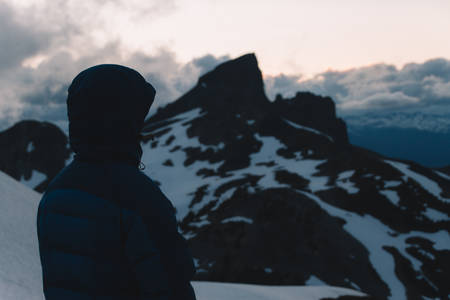Introduction: The Choice Between Solo and Group Hikes
Picture the sun cresting over the jagged peaks of Colorado’s Rockies, wildflowers brushing against your boots as the wind hums through Ponderosa pines. The American backcountry offers endless trails—some winding quietly along the rim of the Grand Canyon, others tracing the misty ridges of the Appalachian Mountains. In these vast landscapes, hikers face a fundamental decision: do you lace up your boots and head out alone, or do you gather a crew to share each mile? This choice isn’t just about logistics or safety; it’s rooted in personal psychology and what we seek from nature. Some crave solitude—the chance to unplug, move at their own pace, and reflect with every step. Others find purpose in camaraderie, swapping stories around a campfire or relying on each other when the trail turns rough. Whether hiking solo or in a group, each path carries its own mental challenges and rewards, shaping not just how we experience America’s wild places but how we grow from them.
2. The Thrill and Challenge of Solo Hiking
Venturing into the wild alone isn’t just about putting one foot in front of the other—it’s a journey deep into your own psyche. For many American hikers, solo treks represent both an exhilarating thrill and a formidable challenge. The psychology behind choosing to hike solo is rooted in three key elements: self-reliance, risk management, and the magnetic pull of solitude.
Self-Reliance: Trusting Yourself on the Trail
Solo hiking demands a unique mental resilience. Unlike group hikes, where decisions and responsibilities are shared, going solo means every choice—from navigation to setting up camp—rests squarely on your shoulders. You quickly learn to trust your instincts and sharpen your problem-solving skills. This mental preparation fosters a sense of independence that echoes the classic American spirit of adventure.
Risk Management: Balancing Freedom with Responsibility
The freedom of solo hiking is balanced by heightened awareness of risks. Without companions to double-check your map or spot hazards, you must continuously assess situations and make judgment calls. The table below outlines essential aspects of risk management for solo hikers:
| Aspect | Solo Hiking Considerations |
|---|---|
| Navigation | Double-check routes; carry backup maps/GPS |
| Emergency Response | Carry a satellite communicator; know evacuation plans |
| Physical Well-being | Monitor energy and hydration vigilantly |
The Appeal of Solitude: Finding Peace in Isolation
For many, the true draw of solo hiking is the serenity found in isolation. Away from the chatter and pace of everyday life, hikers discover space for reflection and mindfulness. American landscapes—from the Rockies to the Appalachians—offer vast stretches where solitude becomes transformative, helping hikers reconnect with nature and themselves. The ability to enjoy one’s own company becomes not just a skill but a reward, making solo hiking a deeply personal experience that shapes both mind and spirit.

3. Benefits and Dynamics of Group Hiking
Group hiking is more than just sharing a trail—it’s about weaving together individual journeys into a collective adventure, something deeply rooted in American outdoor culture. When you hit the trail with others, camaraderie emerges naturally, turning strangers into teammates and friends. Shared experiences—like reaching a summit, navigating a tricky section, or even laughing around a campfire—become stories that bind hikers long after the boots come off.
One of the key psychological benefits is the built-in safety net. In the wild, there’s comfort knowing someone has your back if plans go awry or weather shifts unexpectedly. Group dynamics often create a sense of accountability: you’re motivated to push on when spirits flag, and you learn from each other’s strengths and trail wisdom. It’s teamwork in motion, echoing the American value of pulling together to overcome challenges.
Out on U.S. trails—from the Appalachian backbone to the vast Rockies—this spirit is celebrated. Trail etiquette encourages collaboration: yielding to uphill hikers, sharing snacks, or spotting wildlife for one another. These small acts foster trust and respect among group members, amplifying both safety and enjoyment. Ultimately, hiking as a group is about more than miles covered—it’s about building memories and growing stronger together under big skies and mountain vistas.
4. Mental Strategies for Preparation
Getting your mind ready for a hike—whether youre going solo or with a crew—is just as crucial as packing your boots and water bottle. The way you mentally prepare can shape your entire outdoor experience, from managing pre-hike jitters to enjoying every step on the trail. Here’s how you can set intentions, manage anxiety, and visualize success in ways that fit both solo adventures and group hikes.
Setting Intentions: Know Your Why
Before you even hit the trailhead, take a moment to reflect on your goals. Are you seeking solitude, a physical challenge, or meaningful connection with friends? Setting clear intentions helps anchor your mindset and keeps you focused when the going gets tough.
| Solo Hiking | Group Hiking |
|---|---|
| Set personal goals: mindfulness, resilience, self-discovery | Establish shared objectives: teamwork, fun, support each other |
| Plan for introspection and quiet moments | Agree on communication and pace expectations |
Managing Anxiety: Calm the Nerves
Anxiety is common—especially if you’re venturing into unfamiliar territory or leading a group. Try these strategies to keep your nerves in check:
- Breathe Deep: Practice slow, intentional breaths before and during your hike.
- Break It Down: Focus on one section of the trail at a time instead of the whole journey.
- Prepare Thoroughly: Review maps, weather forecasts, and emergency plans for peace of mind.
- Positive Affirmations: Remind yourself (or your group) of past successes and strengths.
Anxiety-Busting Tips by Setting
| Solo Hiker Tips | Group Hiker Tips |
|---|---|
| Carry a journal to process fears Use calming mantras (“I am prepared”) Trust your gear and training |
Share concerns openly with teammates Lean on group support Delegate roles to reduce stress |
Visualizing Success: See Yourself Thriving
Athletes use visualization to boost performance—and hikers can too! Picture yourself navigating tricky sections confidently, enjoying summit views, or laughing around the campfire. This mental rehearsal primes your brain for real-life achievement.
- Solo: Imagine yourself overcoming obstacles alone and savoring the sense of accomplishment at journey’s end.
- Group: Visualize effective teamwork, clear communication, and shared celebration at key milestones.
Your Mental Prep Checklist
- Define your intention before the hike begins
- Create a plan for managing anxiety (breathing exercises, affirmations)
- Mental rehearsal: visualize both challenges and triumphs ahead of time
- Tune in to what’s unique about solo or group settings—and adjust accordingly!
Mental preparation isn’t just about avoiding pitfalls—it’s about making every mile more meaningful. Whether you’re flying solo or sharing the path, these strategies help turn every hike into an adventure worth remembering.
5. Overcoming Fears and Setbacks on the Trail
Hiking, whether solo or in a group, often brings us face-to-face with our psychological hurdles.
Fear of the Unknown
One of the most common mental barriers is the fear of the unknown. For solo hikers, this can manifest as anxiety about getting lost, facing wildlife, or dealing with unexpected weather. In a group setting, it might look like uncertainty about how group dynamics will play out or if you’ll be able to keep up physically and mentally.
The Weight of Peer Pressure
Group hikes add another layer: peer pressure. Maybe your friends want to push further than you’re comfortable with, or you feel hesitant to speak up when you need a break. This pressure can turn a beautiful trek into a stressful experience if not managed mindfully.
Reframing Challenges as Opportunities
The trail is a living classroom for personal growth. Each fear or setback is an invitation to shift your mindset. Instead of seeing obstacles as threats, try viewing them as opportunities—moments to practice adaptability and resilience. If youre hiking alone and anxiety creeps in, pause, breathe deeply, and break challenges into manageable steps. In groups, communicate openly about your needs; remember that vulnerability can foster stronger connections and collective problem-solving.
Mental Tools for Resilience
Visualization techniques—imagining yourself navigating tough spots successfully—can build confidence before you even set foot on the trail. Journaling your feelings each evening helps process setbacks and celebrate wins, no matter how small. And above all, embrace the unpredictability of nature: every misstep or detour adds depth to your hiking story and strengthens your mental fortitude.
Whether you’re conquering mountains alone or side by side with friends, overcoming fears and setbacks isn’t just about reaching the summit—it’s about learning to trust yourself and adapt with grace along every winding path.
6. Knowing Yourself: Making the Right Choice
When it comes to deciding between solo hiking and group adventures, the most important compass is self-awareness. Before you lace up your boots, take a moment to look inward and reflect on your own goals, personality, and emotional needs. Are you seeking solitude to recharge, or does the idea of sharing stories around a campfire light you up? Understanding these motivations can help ensure your hiking experience aligns with what truly matters to you.
Reflect on Your Personal Goals
Start by asking yourself what you want out of your time on the trail. Are you chasing a sense of accomplishment, craving peace and quiet, or looking to deepen friendships? If self-discovery, mindfulness, or creative inspiration top your list, solo hiking might be your best path. On the other hand, if youre hoping for connection, shared challenges, or just some good company, a group hike could bring more satisfaction.
Consider Your Personality Type
Your natural tendencies play a big role in which style feels right. Introverts often thrive on solo hikes, where the rhythm of their own footsteps and the sounds of nature create a meditative state. Extroverts may find their energy in laughter and conversation along the trail. But remember—these aren’t hard rules. Even social butterflies can enjoy solo treks for reflection, and introverts might surprise themselves by bonding with fellow hikers.
Assess Your Emotional Needs
Think about how you handle challenges and stress. Do you prefer to work through problems alone, or do you lean on others for support? Solo hiking demands self-reliance and resilience; setbacks are yours to navigate. In groups, encouragement and teamwork can help smooth out rough patches. Neither choice is better—it’s about knowing what lifts you up when things get tough.
Ask the Right Questions
Before making your decision, consider these questions: What brings me joy outdoors? How do I recharge after a tough week—alone or with friends? Am I comfortable managing unexpected situations by myself? Honest answers will reveal which hiking style supports not just your adventure goals but also your well-being.
Honor Your Own Journey
No two hikers are alike—and that’s what makes every trek unique. By taking time for self-reflection, you’ll set off in the direction that’s true to you, whether it’s solo under open skies or surrounded by companions on winding trails.
7. Conclusion: Embracing the Journey—Solo or Together
Every trail—whether winding alone through a sunlit canyon or echoing with laughter among friends beneath towering pines—is more than just a path on the map. It’s a living canvas, painted by the red rocks of Arizona, the misty blue ridges of Appalachia, and the snow-dusted peaks of the Rockies. As we prepare mentally for these adventures, we realize that hiking is not only about reaching summits or covering miles; it’s about honoring each step as part of our personal journey. Whether you find solace in solitude or thrive in the camaraderie of a group, remember that every experience shapes your connection to the land and to yourself. So next time you lace up your boots—whether solo or side by side—pause at the trailhead. Take in the vast sky, the scent of pine needles, and the enduring spirit of America’s wild places. Let every hike be a tribute to resilience, discovery, and the unique story you bring to the landscape.


